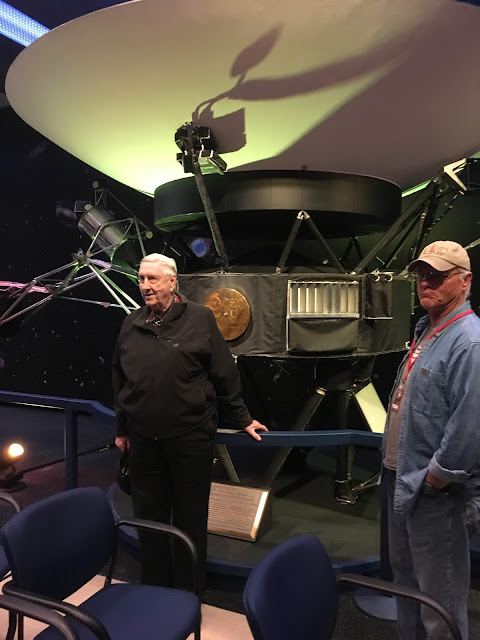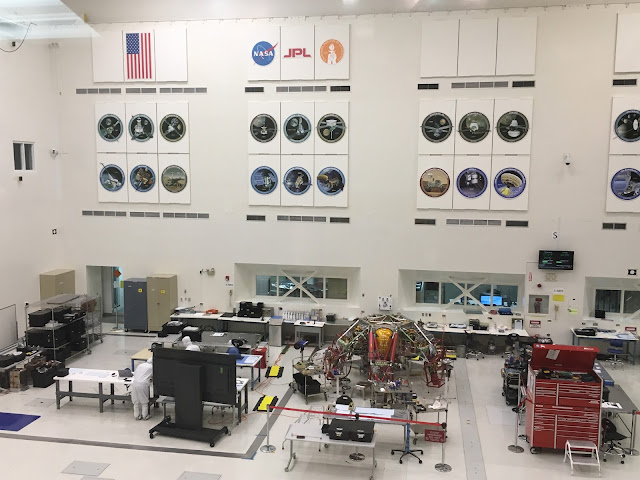I can't believe it took me 66 years to tour the famous Jet Propulsion Laboratory in La Canada/Flintridge. But, the wait was truly worth it. On December 6, I took 53 enthusiastic travelers from the Chicago Club in Laguna Woods to this renown NASA facility. From the minute we arrived to the end of our 2.5 hour tour, we were captivated by what we saw and learned.
 |
| One happy tour guide who grew up in South Pasadena, about 5 miles from this famous facility. |
First of all, I want to share that booking a tour at JPL is quite challenging. You have to go on-line months in advance and compete with hundreds of groups who have the same idea. School group tours are given at 9:30 AM and groups tours for the general public start at 1 PM. Here's a quick run-down of what to expect.
The Jet Propulsion Laboratory, which is managed for NASA by Caltech (California Institute of Technology), is located in a beautiful setting at the foot of the San Gabriel Mountains between Pasadena and La Canada/Flintridge. The facility is huge, with over 110 buildings and approximately 6,000 employees. Of course, the tour only covers a minute portion of the site, but the stops were well-planned and beautiful explained by JPL's public outreach staff.
 |
Nestled between Pasadena and La Canada/Flintridge at the top of the Arroyo Seco canyon, Jet Propulsion
Laboratory is a beautiful campus of 110 buildings. |
The first stop is on the tour is in the Von Karman Auditorium containing models of many of the famous robotic spacecraft that have visited our solar system. Here, the JPL tour guides introduce a short film -
"Journey to the Planets and Beyond," which provides an overview of the Laboratory's activities and accomplishments. Needless to say, the film was chock full of fascinating information and actual images of our neighboring planets. Guests may also visit the von Karman Visitor Center, the Space Flight Operations Facility, and the Spacecraft Assembly Facility. |
Model of Cassini spacecraft in Von Karman Auditorium. The spacecraft was launched
in 1997, arrived at Saturn in 2004 for thirteen years of study, and ended its mission by
crashing into the ringed planet in September 2017. |
 |
| This gentleman on the tour worked on the Voyager spacecraft modeled behind. |
The Golden Records pictured below are also on display in the auditorium. These two records, containing sounds and images meant to portray life on Earth, were placed aboard both Voyager spacecraft in 1977 in the event that intelligent life from our solar system or beyond should encounter them. Our group really enjoyed the fact that, in addition to classical music, the Golden Records also contain the music of rocker Chuck Berry.
 |
| Both Voyager spacecraft contain the Golden Records of life on earth |
The next stop was the highly interactive Von Karman Visitor Center. There were so many interesting planetary exhibits that we could have used more time. The emphasis here is education in the context of excellent graphic displays.
 |
The Juno spacecraft is currently exploring the giant gas planet of Jupiter. We learned that the famous red spot is
actually a storm that is thousands of years old. |
 |
The Cassini spacecraft recently ended its exploratory mission by crashing into Saturn. The JPL scientists couldn't
risk a collision with a Saturnian moon for fear of contamination by Cassini's plutonium fuel source. We also learned
that the rings of Saturn are composed of ice and tiny particles. |
A highlight for our tour group was visiting the Spacecraft Assembly Facility. This decontaminated "clean room" is where the new Mars 2020 rover spacecraft, the largest to ever visit the Red Planet, is being constructed. The scientists in white smocks or "bunny suits" are currently building the vehicle that will lower the Rover onto the martian surface to look for signs of past life, drill for mineral samples, and "cache" these samples for possible return to Earth.
 |
We observed the Spacecraft Assembly Facility from a second story viewing room. The vehicle pictured below is part of the Mars 2020 rover program, meant to build on the success of the car-sized Curiosity rover, launched in 2011.
Our last stop was a rare treat - a visit to the Space Flight Facility Operations Facility. This is the control room where NASA's Deep Space Network is operated and monitored. It is so famous, in fact, that it has been designated a National Historic Landmark (there are only about 2,500 such landmarks in the whole country) since it has monitored all interplanetary and deep space explorations. Apparently, depending on what's happening on a particular day, not all groups have the pleasure of visiting this area. We were lucky! |
 |
At the Space Flight Operations Facility, our excellent guide continued to answer questions and share fascinating
stories. On the other side of the glass windows, JPL scientists were monitoring current missions. |
 |
I was pleasured and fascinated that the Space Flight Operations Facility was designated a National Historic Landmark -
the highest designation that the Department of Interior bestows. |
 |
Earth radar must have a continuous line-of-sight with the various spacecraft and satellites monitored by
JPL. For this reason, it has radar in the California desert; Madrid, Spain; and Australia. JPL literally
never loses sights of its missions! |
 |
Notice the badges of the all the JPL missions on the wall in the back of the Spacecraft Assembly Facility.
The tour could have lasted much longer, but it was wonderfully informative. There is a very small gift store at the end near the Visitor Center. Remember to check out the great JPL website to book a tour (which you have to do months in advance) and explore the storied history and missions of this incredible facility. My group decided that Jet Propulsion Laboratory and its dedicated and talented staff represent the best of our country. For so many of us, space and the cosmos capture the imagination like nothing else, and here at JPL we could truly whet our curiosity. I'm ready to launch another tour soon! |
 |
| One happy Hoffy tour guide who finally made it to JPL! |

